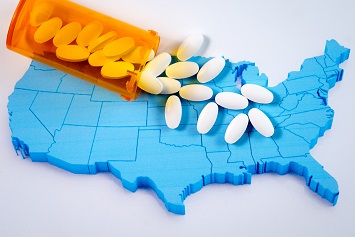The EPA is playing a minor but important role in the federal government’s efforts to control America’s opioid overdose epidemic. In its latest action, the Agency’s Office of Resource Conservation and Recovery (ORCR), which implements the EPA’s solid waste program under the Resource Conservation and Recovery Act (RCRA), issued a memo to encourage law enforcement agencies and offices to run take-back programs for unused or expired prescription opioids.
The memo summarizes the federal laws that govern the possession, transportation, and disposal of opioids. The memo acknowledges that some local law enforcement offices have been reluctant to participate in take-back programs because they are uncertain about what should be done with the opioids they receive, as well as their legal responsibilities and liabilities. The basic message to law enforcement is that there is only one acceptable way to dispose of take-back opioids—incineration. The memo goes on to describe the various appropriate incineration options available to them and the one option—open burning—that is not appropriate.
The Epidemic
According to the U.S. Department of Health and Human Services (HHS), the seeds of the current opioid epidemic were planted in the 1990s when pharmaceutical companies assured the medical community that patients would not become addicted to opioid pain relievers; accordingly, healthcare providers began to prescribe opioids at greater rates.
“Increased prescription of opioid medications led to widespread misuse of both prescription and non-prescription opioids before it became clear that these medications could indeed be highly addictive,” HHS now states.
From 1999 to 2016, more than 200,000 people in the United States died from overdoses related to prescription opioids, reports the Centers for Disease Control and Prevention. Overdose deaths involving prescription opioids were five times higher in 2016 than in 1999. Moreover, HHS reports that 2.1 million people who were misusing opioids began the misuse with prescription opioids; this contrasts with 170,000 people who began opioid misuse with heroin.
“Prescription opioids, even when used as prescribed by a doctor can lead to a substance use disorder,” states the National Institute on Drug Abuse.
Waste Pharmaceutical Proposal
The ORCR’s memo is not the first time the EPA has addressed the management of unused or expired prescription medications, including opioids. Prescription drugs number in the thousands, and when expired, they may qualify as a listed hazardous waste under RCRA or may meet one of the four hazardous waste characteristics. Healthcare facilities in particular accumulate waste pharmaceuticals. While many of these facilities do not generate a sufficient monthly amount of hazardous waste to become subject to the full regimen of RCRA regulations, any facility that generates more than 1 kilogram of acute hazardous waste in a month is a RCRA large quantity generator (LQG) that must meet all the federal hazardous waste requirements. (Many states are authorized by the EPA to implement RCRA provisions. These states may impose requirements that are more stringent than the EPA’s. Operators of any facility where hazardous waste is generated must check with their state solid waste departments to determine their requirements.)
The EPA has long recognized that healthcare facilities are not the type of industrial hazardous waste-generating operations that RCRA was written to regulate. Healthcare facilities as well as pharmacies and other retail businesses that may accumulate waste pharmaceuticals are typically unfamiliar with RCRA and may be in noncompliance out of simple ignorance. In 2008, the EPA attempted to address the problem by proposing to list waste pharmaceuticals as a universal waste. The federal universal waste program offers streamlined RCRA requirements for certain high-volume, low-risk wastes (e.g., pesticides and mercury-containing equipment) that are often generated by businesses and residences. But the universal waste option for pharmaceuticals prompted negative feedback from environmental groups, largely because of the lack of notification and cradle-to-grave tracking requirements. The EPA dropped the proposal.
In 2015, the EPA tried again by proposing another streamlining rule. The action focused on healthcare facilities, which would need to meet core RCRA hazardous waste requirements such as waste characterization and manifesting. But the proposal would simplify these steps. For example, the healthcare facility would not need to identify the specific waste codes applying to the pharmaceutical waste, and therefore, no codes would need to be included on the manifest. The proposal would also extend the period during which healthcare facilities can accumulate pharmaceutical waste without obtaining a RCRA storage permit.
According to news reports, the Trump EPA views the proposal as aligned with its deregulatory agenda, and a final rule may appear before the end of 2018.
10 Million Pounds Collected
The EPA’s 2015 proposal was mainly concerned with disposal of unwanted pharmaceuticals down the drain at healthcare facilities, which potentially contaminates water bodies. But the focus in the ORCR’s memo is on keeping opioids out of the hands of potential abusers. In the memo, EPA Administrator Andrew Wheeler notes that the U.S. Drug Enforcement Administration (DEA) sponsors two National Prescription Drug Take Back days a year. On the most recent take-back day, law enforcement established nearly 6,000 collection sites nationwide and collected nearly 1 million pounds (lb) of unwanted drugs. Since inception of the program in 2010, the DEA has collected nearly 10 million lb of these pharmaceuticals. Law enforcement may also collect these drugs at other times.
“Given the volume of drugs collected, it is important that the collection and disposal of these drugs is done in a manner that protects human health and the environment,” writes Wheeler. “As such, the EPA coordinates regularly with the DEA, the U.S. Department of Transportation, and the U.S. Postal Service to provide law enforcement agencies with specific information they can use on how best to manage household drugs collected in take-back programs.”

Three Laws
The memo clarifies how federal laws apply to drug take-back programs.
RCRA. Pharmaceuticals that are unwanted (e.g., expired or unused) by consumers are not regulated federally as hazardous wastes and are generally handled through municipal solid waste collection and disposal systems. Although many pharmaceutical wastes meet the definition of hazardous waste under RCRA, federal regulations exempt all hazardous waste generated by households. Thus, household pharmaceutical wastes are not subject to the federal RCRA hazardous waste regulations even when collected at a take-back event or program.
Controlled Substances Act (CSA). Under the CSA and implementing regulations published by the DEA, only persons registered with the DEA are permitted to possess controlled substances and must comply with the applicable requirements associated with their registration. However, there are exceptions. For example, when carrying out their official duties, law enforcement personnel are not required to register with the DEA to receive and possess controlled substances. Additionally, a patient who receives a controlled substance pursuant to a lawful prescription is not required to register with the DEA to receive and possess that controlled substance.
The Secure and Responsible Drug Disposal Act of 2010. This law and the DEA’s implementing regulations provide the basic framework to allow the public to dispose of their unwanted or expired prescription pharmaceuticals in a secure and responsible manner. Until the DEA finalized the implementing regulations for the Act, the public could not deliver their controlled substance pharmaceuticals to any person for disposal other than by surrender to law enforcement, including at a take-back event with law enforcement present. Since the DEA finalized the implementing regulations, there are now additional options for ultimate users, including collection receptacles at retail and hospital pharmacies, as well as mail-back envelopes.
Also, DEA regulations require that controlled substances collected by DEA registrants that are authorized collectors of ultimate user pharmaceuticals (e.g., in take-back programs) must be destroyed so that they are nonretrievable. Although law enforcement is not required to meet the DEA regulations that apply to DEA registrants, the DEA regulations state, “Any controlled substances collected by law enforcement through a take-back event, mail-back program, or collection receptacle should be transferred to a destruction location in a manner that prevents the diversion of controlled substances.”
Incineration Methods
The Agency recommends incineration—which is not required—rather than landfilling as the preferred method for destruction of household pharmaceuticals collected in take-back programs. Law enforcement can make use of several types of solid waste and hazardous waste combustion units to destroy household pharmaceuticals. Because the collected household pharmaceuticals are solid waste, they must be sent for disposal/destruction in a hazardous waste combustor regulated under Section 112 of the Clean Air Act (CAA) or one of the following solid waste incineration units regulated under CAA Section 129:
- Large and small municipal waste combustors (MWCs);
- Hospital, medical, and infectious waste incinerators (HMIWIs);
- Commercial and industrial solid waste incinerators (CISWIs); or
- Very small municipal waste combustors that are regulated as other solid waste incinerators (OSWIs).
The memo states;
“Thus, law enforcement has a variety of options for disposing and destroying of collected household pharmaceuticals that meet EPA’s mandate of protecting human health and the environment. Although EPA encourages the owners/operators of these incinerators to consider accepting the collected household pharmaceuticals and a number have recognized the unique services they offer and role they can play in helping to mitigate the national opioid epidemic, we note that these incinerators are not obligated to accept collected household pharmaceuticals for destruction.”
Transport
The memo states that transporting pharmaceuticals to approved incinerators can be costly. Another option for law enforcement is to transport the materials to any of 35 reverse distributors authorized by the DEA to accept shipments of collected household pharmaceuticals. While some DEA registered reverse distributors operate incinerators, most do not. Those that do not operate incinerators must deliver the collected household pharmaceuticals that they receive to an incinerator and witness their destruction on behalf of law enforcement. Reverse distributors and incinerators may be willing to provide service to law enforcement at reduced rates.
“We encourage law enforcement to contact multiple vendors and compare pricing for liners/outer packaging and for handling and destruction,” says the ORCR. “We also note that law enforcement should look for a vendor that is compliant with the Department of Transportation’s hazardous material regulations for shipping collected household pharmaceuticals.
Open Burning
Finally, the ORCR says it has received inquiries from law enforcement about whether open burning of pharmaceuticals collected in take-back events is allowed.
“Open burning of residential, commercial, institutional, or industrial solid waste is prohibited under RCRA Subtitle D regulations in 40 CFR 257.3-7(a),” the ORCR responded. “Additionally, in many cases, state laws and local ordinances strictly limit or prohibit open burning of household waste.”
The ORCR adds that open burning generally occurs in metal barrels. While some barrels may be equipped with fans to direct the fumes, this method may not control emissions of hazardous air pollutants that can be formed as by-products of combustion. Pollutants such as dioxins, furans, lead, mercury, and hexachlorobenzene may cause immediate and long-term adverse health effects, such as cancer, respiratory illness, and reproductive disorders. Furthermore, given the comparatively low combustion temperature and the difficulty of controlling the combustion temperature, it is not clear that open burning in burn barrels would achieve the DEA’s nonretrievable standard for the destruction of controlled substances.
The ORCR’s memo and other EPA documents on the management of pharmaceutical hazardous wastes are at https://www.epa.gov/hwgenerators/management-pharmaceutical-hazardous-waste.

